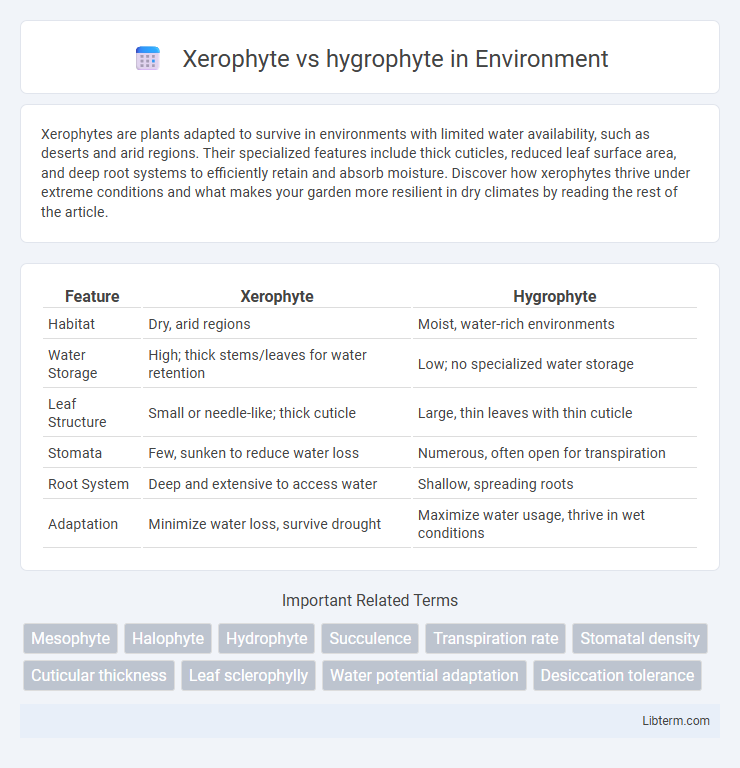Xerophytes are plants adapted to survive in environments with limited water availability, such as deserts and arid regions. Their specialized features include thick cuticles, reduced leaf surface area, and deep root systems to efficiently retain and absorb moisture. Discover how xerophytes thrive under extreme conditions and what makes your garden more resilient in dry climates by reading the rest of the article.
Table of Comparison
| Feature | Xerophyte | Hygrophyte |
|---|---|---|
| Habitat | Dry, arid regions | Moist, water-rich environments |
| Water Storage | High; thick stems/leaves for water retention | Low; no specialized water storage |
| Leaf Structure | Small or needle-like; thick cuticle | Large, thin leaves with thin cuticle |
| Stomata | Few, sunken to reduce water loss | Numerous, often open for transpiration |
| Root System | Deep and extensive to access water | Shallow, spreading roots |
| Adaptation | Minimize water loss, survive drought | Maximize water usage, thrive in wet conditions |
Introduction to Xerophytes and Hygrophytes
Xerophytes are plants adapted to survive in arid environments with minimal water availability, exhibiting features such as thick cuticles, reduced leaf surface area, and deep root systems to minimize water loss. Hygrophytes thrive in moist or water-saturated habitats and develop characteristics like thin cuticles, large leaf areas, and extensive aeration tissues to manage excess water. These physiological and structural adaptations highlight the contrast in water management strategies between xerophytes and hygrophytes.
Key Differences Between Xerophytes and Hygrophytes
Xerophytes thrive in arid environments with adaptations such as thick cuticles, reduced leaf surface area, and deep root systems to minimize water loss. Hygrophytes prefer moist habitats and exhibit features like thin cuticles, large leaves, and aerenchyma tissues for efficient water absorption and gas exchange. The key differences lie in their morphological and physiological traits tailored to water availability, with xerophytes specialized for drought resistance and hygrophytes for moisture abundance.
Morphological Adaptations of Xerophytes
Xerophytes exhibit specialized morphological adaptations such as thick, waxy cuticles, reduced leaf surface area, and sunken stomata to minimize water loss in arid environments. Their extensive root systems maximize water absorption, while succulent tissues store moisture for prolonged drought periods. These features contrast sharply with hygrophytes, which possess thin leaves and numerous stomata to facilitate transpiration in humid conditions.
Morphological Adaptations of Hygrophytes
Hygrophytes exhibit morphological adaptations such as large, thin leaves with a high density of stomata to facilitate efficient transpiration and gas exchange in moist environments. Their tissues often have aerenchyma, specialized spongy parenchyma that enhances aeration in waterlogged soils. These plants typically possess shallow root systems to maximize water uptake from saturated soil surfaces.
Physiological Mechanisms in Xerophytes
Xerophytes exhibit specialized physiological mechanisms such as CAM photosynthesis, where stomata open at night to minimize water loss while maximizing CO2 uptake. Their thick cuticles and sunken stomata reduce transpiration by creating a microenvironment that retains moisture. Efficient water storage in succulent tissues and osmotic adjustments help xerophytes maintain cellular hydration under arid conditions.
Physiological Mechanisms in Hygrophytes
Hygrophytes exhibit specialized physiological mechanisms such as high stomatal density and large, thin leaves to maximize transpiration and gas exchange in moist environments. Their root systems efficiently absorb abundant water, while their thin cuticles reduce resistance to water vapor diffusion. These adaptations maintain cellular water balance and support photosynthesis under saturated humidity conditions.
Habitat and Environmental Requirements
Xerophytes thrive in arid, dry habitats with minimal water availability, such as deserts and semi-deserts, adapting to extreme drought conditions by conserving moisture. Hygrophytes are found in moist, water-rich environments like swamps, marshes, and rainforests, requiring high soil moisture and humidity for optimal growth. The contrasting environmental requirements highlight xerophytes' adaptations to water scarcity and hygrophytes' need for abundant water supply.
Reproductive Strategies in Xerophytes and Hygrophytes
Xerophytes exhibit reproductive strategies such as producing seeds with tough coatings and extended dormancy to survive arid conditions, ensuring successful germination during rare moisture events. Hygrophytes rely on abundant water availability to produce large quantities of lightweight seeds or spores that disperse efficiently in moist environments, facilitating rapid colonization. These contrasting strategies reflect adaptations to extreme water scarcity in xerophytes and water abundance in hygrophytes for reproductive success.
Ecological Importance and Roles
Xerophytes play a crucial ecological role in arid and semi-arid environments by stabilizing soils, reducing erosion, and supporting biodiversity adapted to water-scarce conditions. Hygrophytes contribute significantly to wetland ecosystems by enhancing water purification, providing habitats for aquatic and semi-aquatic species, and maintaining hydrological cycles. Both plant types are essential for sustaining ecological balance in their respective habitats through their specialized adaptations to moisture availability.
Conclusion: Comparing Xerophytes and Hygrophytes
Xerophytes exhibit adaptations such as thick cuticles, reduced leaf surfaces, and deep root systems to conserve water in arid environments, while hygrophytes possess features like thin cuticles, large leaves, and extensive stomata to facilitate moisture absorption in wet habitats. The fundamental contrast lies in their water management strategies, with xerophytes minimizing water loss and hygrophytes maximizing water uptake. These specialized adaptations illustrate the evolutionary responses of plants to extreme moisture conditions, defining their ecological niches.
Xerophyte Infographic

 libterm.com
libterm.com